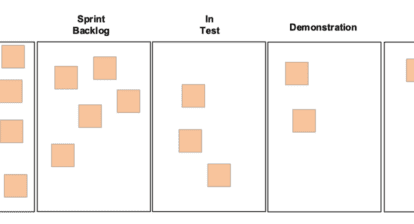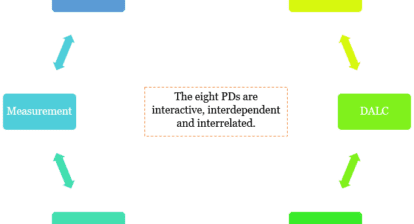Wondering how to get your message across? Here are some tactics that, while unconventional — and in some cases uncouth — work like a charm.
Grab Attention. If you are co-located with your team, you have a fabulous opportunity to capture their attention visually.:
- Purchase a life-size cardboard figure of the celebrity of your choice (movie star, political figure, Disney character, whatever) and position them just outside of the team meeting room with the top priority Project Goals or next big milestone in their hands, paws, or tentacles.
- Create a screensaver that conveys the purpose, goals, and priorities of the project. Make the background picture irresistible so that people can’t help but load it onto their computers. (The CEO playing “Whack-A-Mole” is always popular.) Better yet, have your IT Department make this the default screensaver on everyone’s PC.
- Post the one-page project timeline — or any other time-critical project communication — inside the restrooms in “strategic” places, places you can be sure people will be looking at for at least a few minutes a day. (Common decency dictates that I not provide any further detail. You know what I mean!)
- Give them a little something “extra” in every email communication. Foster the expectation that your email will entertain as well as inform, via a joke, anecdote, riddle, or inspirational saying. This will increase the likelihood of your messages being read — or at least opened, which is half the battle.
- Use poetry to communicate some critical project details. One unstoppably creative project leader used this technique to increase the on-time attendance at a daily status meeting during a critical juncture. People showed up on time to hear the kick-off poem that captured key issues for the day’s meeting.
The “E” in Email. Now let’s talk about the global plague that has hit communication in the 21st century. I’ve had it with project leaders who think that their whole job can be done from a keyboard! I recently helped one of my client companies hire a project manager for a professional services business. The CEO told me they wanted help because “the last three project managers didn’t work out.” Yeah, that’s a big warning sign that something’s cookin’ in the project management kitchen. It seems that the last project manager was there for a year and had NEVER been to visit a customer. Now, mind you, this was a professional services firm, and the people working on the projects were pretty much always at the customer site. I innocently asked, “How did this person manage the project?” The answer, of course, was email. Paper cuts all over my body just prior to a lemon juice bath couldn’t have sent me into more intense convulsions.
A project leader with an addiction to email is destined for trouble. Are you addicted? Here’s a quick check-up. Test yourself against these behaviors, all of which I have observed to be epidemic in the stress-fest work environments where I consult:
- The first thing you do when you walk in the door in the morning is check email and clear out your in-box.
- You monitor email all day long.
- You continue to read and respond to email while people are in your office talking with you.
- You send an email to communicate important news instead of holding a meeting.
- You send critical documents that require feedback from busy people as attachments to email and expect them to actually read them.
If even one of these statements describes you, give yourself a good slap across the face, splash water over your stinging skin, and seek help immediately! Surf the web for support groups, call Email-aholics Anonymous, explore your relationship with your higher power, whatever it takes! These are not the characteristics of a highly respected project leader. They are the behavior of an administrator and bureaucrat! Project leaders need to lead, not read, and you can’t do that from behind a keyboard.
Now, I know there are plenty of people out there who are going to dash off an email to me protesting that email is a vital project management tool. For years I have been asserting that email is not a form of communication, so I’m familiar with the pushback. But in my opinion, email is a data transmission tool. OK, sometimes it is pretty handy, but honestly, don’t you think we’ve gone too far? Too often the “e” in email stands for:
- Evasive — as in a cowardly alternative to a difficult conversation.
- All too Easy — as in “the easy way out” of something that deserved a face-to-face chat, or at least a phone call. Or just plain easy for you, and harder for everyone else.
- Evil — as in nastygrams that would never have been spoken, and are now preserved forever in some hard drive out there in some server farm.
- And last but not least, Efficient, but ineffective.
I’m not even going to try to capture a thorough list of email best practices. Jeff Sandquist already did a great job of that. (Have a look at his web site.) But here are a few tips about some particular burrs under my email-chaffed saddle that I’m just itching to eliminate from the
face of the planet.
- Avoid the “hydra” email — an email covering several different topics, each of which requires something from the receivers. Limit each email to one topic, clearly labeled in the subject line, and put “Action Requested” in the subject if you need a response. Winston Churchill used this technique with paper memos, but he was much more blunt, writing the phrase “ACTION REQUIRED THIS DAY” on those concerning urgent matters.
- Don’t even think about sending anything remotely sensitive or emotional in an email. If you must write some emotional verbal vomit in an email, at least have the decency and good sense to delete it before sending it. Or send it to yourself. You probably deserve it more than the poor bastard you addressed it to.
- Keep in mind that the person who reads your email gets to imagine your tone of voice and interpret your meaning. No matter how carefully you write, you only control a small percentage of the meaning that will be conveyed. The rest will be supplied by the vivid imagination of the receiver.
- Never use BCC. NEVER! If you must secretly let someone else know about some message that you sent, copy yourself and then forward a copy to that other person. For pity’s sake, this is for your own good. If the person receiving the BCC hits “Reply All” you will be outted for the sneaky rascal that you probably are.
- Don’t play email ping-pong. After a couple of volleys back and forth, pick up the damn phone, or better yet, pay a personal visit to the other person. They probably sit less than ten meters away from you anyhow, and you can probably use the exercise.
All things said and done, it doesn’t matter whether you send emails or smoke-signals to convey your messages, just so long as you communicate! Communication is absolutely essential for project success, so make sure you communicate early, often, and effectively. It’s the leader’s job to make sure his message is received and understood. There is no excuse for failing because of an entirely predictable and avoidable problem like communication breakdown. Make no mistake, effective communication is hard work and takes constant vigilance.







